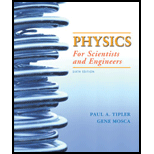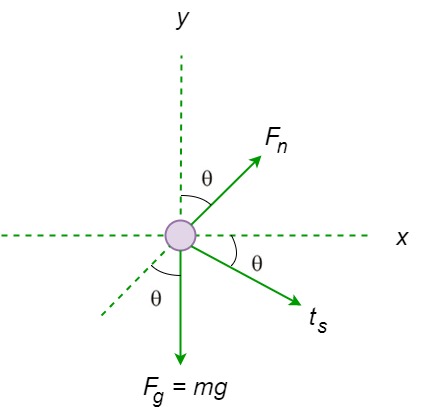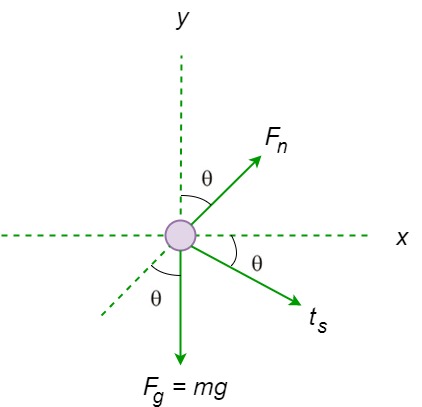
Concept explainers
(a)
To Find:The normal force.
(a)
Answer to Problem 95P
Explanation of Solution
Given Information:
Mass of the car
Angle of incline,
Radius of curvature,
Speed of car is
Formula Used:
Newton’s second law of motion:
Calculation:
The free body diagram shows the forces acting the car.

Speed of the car
Apply
Apply
Multiply the equation
Add the equation
Solving the above equation for
Substitute all the known values in equation
Conclusion:
Therefore, the normal force is
(b)
To Find:The frictional force exerted.
(b)
Answer to Problem 95P
Explanation of Solution
Given Information:
The speed of car on the curve road is
Formula Used:
Newton’s second law of motion:
Calculation:
The free body diagram shows the forces acting the car.

Apply
Solving the equation
Calculation:
Therefore, the frictional force is
Here the negative sign indicates that force
Want to see more full solutions like this?
Chapter 5 Solutions
Physics For Scientists And Engineers
- On an alien planet, an object moving at 4.0 m/s on the horizontal ground comes to rest after traveling a distance of 10 m. If the coefficient of kinetic friction between the object and the surface is 0.20, what is the value of g on that planet?arrow_forwardIf a block of mass m lies on a wedge of mass M, here all surfaces are smooth, and the block slips on the wedge, will the wedge have any acceleration? If yes, explain why and of what magnitude?arrow_forwardAssuming an unbanked curve, find the minimum static coefficient of friction, between the tires and the road, static friction being the reason that keeps the car from slippingarrow_forward
- A ball of mass 5 kg and block of mass 12 kg are attached by lightweight cord that passes Over frictionless pulley of negligible mass as shown in the figure. The block lies on frictionless incline of angle 30 . Find the magnitude of the acceleration of the two objects and the tension in the cord Take g = 9.8 ms : 12 kgarrow_forwardAs shown below, the mass of block 1 is m1 = 4.0 kg, while the mass of block 2 is m2 = 8.0 kg. The coefficient of friction between m1 and the inclined surface is μk = 0.40. What is the acceleration of the system?arrow_forwardIn a soccer match against Mexico in 2014, US Women’s National Team striker Alex Morgan scored a sweetheaded goal in the 79th minute of the game. Just as the ball left her head, the horizontal component of its acceleration was 225 m/s , and the vertical component of its acceleration was -200 m/s (assuming thepositive direction points up). If the ball has a mass of 425 g, what was the magnitude and direction of theforce she applied to the ball? Note- you can ignore the weight of the ball.arrow_forward
- In a television commercial, a small, spherical bead of mass 4.00 g is released from rest at t = 0 in a bottle of liquid shampoo. The terminal speed is observed to be 2.00 cm/s. Find (a) the value of the constant b in the equation v = mg/b (1 − e−bt/m), and (b) the value of the resistive force when the bead reaches terminal speed.arrow_forwardIf the only forces acting on a 2.0kg mass are F1=(3i-8j)N and F2=(5i+3j)N, what is the magnitude of the acceleration of the particle?arrow_forwardIn the very Dutch sport of Fierljeppen, athletes run up to a long pole and then use it to vault across a canal. At the very top of his arc, a 55 kg vaulter is moving at 2.5 m/s and is 5.1 m from the bottom end of the pole. What vertical force does the pole exert on the vaulter?arrow_forward
- A block of mass m2 on a rough, horizontal surface is connected to a ball of mass m1 by a lightweight cord over a lightweight, frictionless pulley as shown in 5.21a. A force of magnitude F at an angle θ with the horizontal is applied to the block as shown, and the block slides to the right. The coefficient ofkinetic friction between the block and surface is μk. Determine the magnitude of the acceleration of the two objects.arrow_forwardA ball of mass m_(1) and a block of mass m_(2) are attached by a lightweight cord that passes over a frictionless pulley of negligible mass as in Figure 5.16a. The block lies on a frictionless incline of angle \theta . Find the magnitude of the acceleration of the two objects and the tension in the cord.arrow_forwardA 70 kg bicyclist is riding her 15 kg bicycle downhill on a road with a slope of 80without pedaling or braking. The bicyclist has a frontal area of 0.45 m2and a dragcoefficient of 1.1 in the upright position, and a frontal area of 0.4 m2and a dragcoefficient of 0.9 in a racing position. If the downhill speed of the bicyclist(terminal velocity) can be determined when the total force acting on the “body” inthe direction of movement is equal to zero, determine the percentage of downspeed that she can be increased when she is in a racing position. Air temperatureis 150C and disregarding the rolling resistance and friction at the bearing.arrow_forward
 Principles of Physics: A Calculus-Based TextPhysicsISBN:9781133104261Author:Raymond A. Serway, John W. JewettPublisher:Cengage Learning
Principles of Physics: A Calculus-Based TextPhysicsISBN:9781133104261Author:Raymond A. Serway, John W. JewettPublisher:Cengage Learning Classical Dynamics of Particles and SystemsPhysicsISBN:9780534408961Author:Stephen T. Thornton, Jerry B. MarionPublisher:Cengage Learning
Classical Dynamics of Particles and SystemsPhysicsISBN:9780534408961Author:Stephen T. Thornton, Jerry B. MarionPublisher:Cengage Learning

